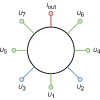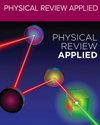Critical nonlinear aspects of hopping transport for reconfigurable logic in disordered dopant networks
IF 4.4
2区 物理与天体物理
Q2 PHYSICS, APPLIED
引用次数: 0
Abstract
Nonlinear behavior in the hopping transport of interacting charges enables reconfigurable logic in disordered dopant network devices, where voltages applied at control electrodes tune the relation between voltages applied at input electrodes and the current measured at an output electrode. From kinetic Monte Carlo simulations we analyze the critical nonlinear aspects of variable-range hopping transport for realizing Boolean logic gates in these devices on three levels. First, we quantify the occurrence of individual gates for random choices of control voltages. We find that linearly inseparable gates such as the xor gate are less likely to occur than linearly separable gates such as the and gate, despite the fact that the number of different regions in the multidimensional control voltage space for which and or xor gates occur is comparable. Second, we use principal-component analysis to characterize the distribution of the output current vectors for the (00,10,01,11) logic input combinations in terms of eigenvectors and eigenvalues of the output covariance matrix. This allows a simple and direct comparison of the behavior of different simulated devices and a comparison to experimental devices. Third, we quantify the nonlinearity in the distribution of the output current vectors necessary for realizing Boolean functionality by introducing three nonlinearity indicators. The analysis provides a physical interpretation of the effects of changing the hopping distance and temperature and is used in a comparison with data generated by a deep neural network trained on a physical device.

无序掺杂网络中可重构逻辑的跳变传输的关键非线性问题
在无序掺杂网络器件中,施加在控制电极上的电压可以调整施加在输入电极上的电压与在输出电极上测量到的电流之间的关系。通过动力学蒙特卡洛模拟,我们从三个层面分析了在这些器件中实现布尔逻辑门的变程跳变传输的关键非线性方面。首先,我们量化了随机选择控制电压时单个栅极的出现情况。我们发现,尽管在多维控制电压空间中出现和或 xor 门的不同区域数量相当,但线性不可分割门(如 xor 门)出现的概率低于线性可分离门(如和门)。其次,我们利用主成分分析法,以输出协方差矩阵的特征向量和特征值来描述 (00,10,01,11) 逻辑输入组合的输出电流向量分布。这样就可以简单直接地比较不同模拟设备的行为,并与实验设备进行比较。第三,我们通过引入三个非线性指标,量化了实现布尔功能所需的输出电流矢量分布的非线性。该分析为改变跳变距离和温度的影响提供了物理解释,并用于与在物理设备上训练的深度神经网络生成的数据进行比较。
本文章由计算机程序翻译,如有差异,请以英文原文为准。
求助全文
约1分钟内获得全文
求助全文
来源期刊

Physical Review Applied
PHYSICS, APPLIED-
CiteScore
7.80
自引率
8.70%
发文量
760
审稿时长
2.5 months
期刊介绍:
Physical Review Applied (PRApplied) publishes high-quality papers that bridge the gap between engineering and physics, and between current and future technologies. PRApplied welcomes papers from both the engineering and physics communities, in academia and industry.
PRApplied focuses on topics including:
Biophysics, bioelectronics, and biomedical engineering,
Device physics,
Electronics,
Technology to harvest, store, and transmit energy, focusing on renewable energy technologies,
Geophysics and space science,
Industrial physics,
Magnetism and spintronics,
Metamaterials,
Microfluidics,
Nonlinear dynamics and pattern formation in natural or manufactured systems,
Nanoscience and nanotechnology,
Optics, optoelectronics, photonics, and photonic devices,
Quantum information processing, both algorithms and hardware,
Soft matter physics, including granular and complex fluids and active matter.
 求助内容:
求助内容: 应助结果提醒方式:
应助结果提醒方式:


